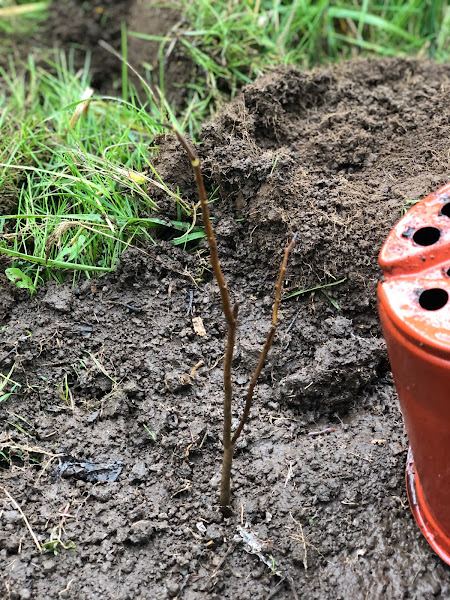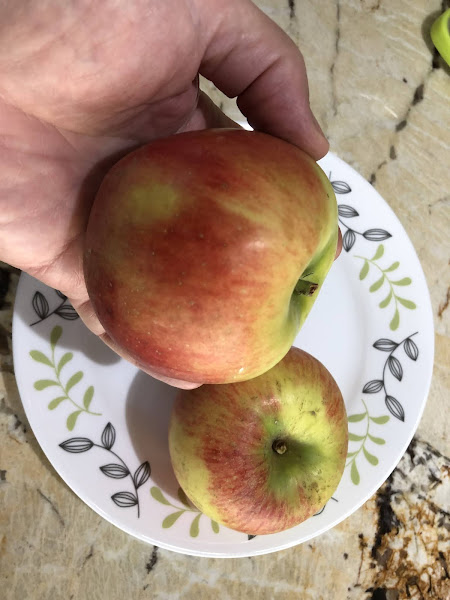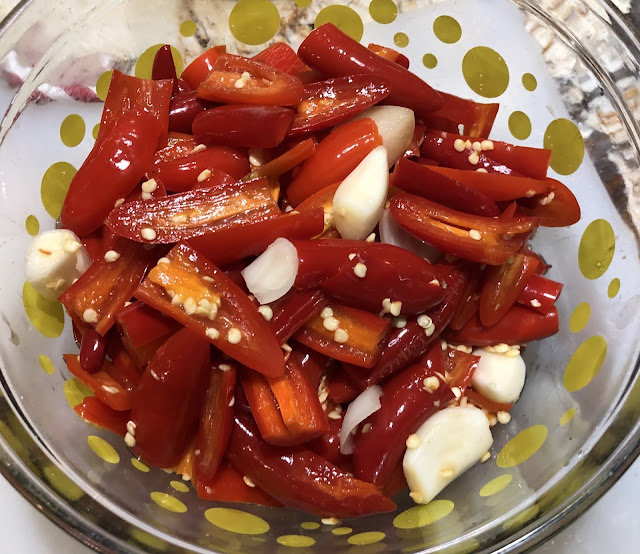Wednesday, October 20, 2021
Cooking a Jumbo Size "Illinois" Squash. 10.20.2021
This week I butchered an Illinois squash and made several things from it. There wasn't much wasted.
The back story of this open-pollinated variety is that Abraham Lincoln's family bought the seeds when they lived in Kentucky. When they moved to Illinois, they took seeds along for the move. They grew these in New Salem. Seeds were given or sold to neighbor families, some of whom grew them for generations, passing the seeds down to their descendants. Finally, some seeds wound up with seed merchants, and I bought these from rareseeds.com.
This is a moschata species squash, and all of my other squashes were ither species, so they should grow true from saved seeds.
This squash was 18 pounds. It was way to big to roast without making some slices.
I set aside one one-pound section to be included as 1-inch cubes in the next 8-day supply of dog food, and a 2-cup portion of cubes for the day's squash soup. The rest were roasted at 375 F for 90 minutes until tender. Then I scooped out or sliced off the toased flesh and pureed for future soups or pies.
This squash came out lemon yellow. I froze 6 2-cup freezer bags of puree for future use. I also rinsed off the seeds and let them dry to save for next year.
I did make a pie with one bag of puree. Despite being lemon yellow, the pie came out a rich chestnut brown. The recipe is the same as pumpkin pie, except I substitute coconut milk for evaporated milk. Very tasty pie for sure.
Sewing Upcycled Chinos Grocery Totes. 10.29.2021
Ning had some chinos that he wore at work before retiring, and no longer wears. they are a good quality, rugged fabric. The cuffs were frayed and there was wear on the beltline. The rest of the fabric is tough and undamaged. With new Washington State requirements to stop one-use plastic bags at grocery stores, I decided to make some totes he can keep in his car for shopping trips. I already have some like these in my car.
The pattern was an old tote from the era when they were made with thinner plastuc than new ones. The size and shape are almost exactly the same as a large brown paper grocery bag.
First, cut off the belt line and zipper, and cut the inseams to open the fabric panels.
Then measure out how the bag panels will fit together. They usually require some piecing for the end / bottom panel.
I finally changed the long panel to three shorter cross-wise rectangles, which I pieced together to make a single long section. That worked better with these fabric sections.
Then I piece together the bagand handles. It's all the same shape as the original, old bags although I give it an extra inch in every direction for size. The handles are also made the same as the original bags.
I think this uses about 90% if the fabric from the original chinos. There might be enough remaining to make a cadet cap, I'm not sure. It would be good fabric for that. These bags are highly durable and strong. By upcycling cotton fabric, there is no environmental issue involving the high impact of virgin cotton. One tote holds as much as four disposable one-use plastic begs would hold, without tearing. They are clothing, so can be washed and dried exactly the same as the original trousers, as needed. Store bought canvas totes shrink like crazy when washed. These are highly ore-washed already. They won't shrink at all. I've used denim but it's rough on my sewing machine. The chino cotton is still heavy, but not as heavy as denim, so it sews without any problems. The photo is 2 totes. There are two more to be made, but not for a while.
Edit 11.9.21 Here are the dimensions for the bad, not necessarily to scale.
Planning a Table Top Quilt for Fall. 10.20.2021
This is for Ning's dumpling rolling table. He uses a coffee table and sits at the couch to roll out dumplings. I thought it would be nice to have a padded and washable surface, with the rolling board to sit on top.
These are from a fabric sampler fabric strip roll that I bought on close out sale on the internet. I sewednthe 2 1/2" strips together in groups of three, then cut the result wide strips into 6 1/2 inch squares. With a 1/4 inch seam allowance, the final squares are 6". Here they are laid out on the kitchen island.
It's nice taking a cellphone photo so I can reassemble the peices in the pattern I laid out here. Also, the cellphone photo seems to sharpen oatterns that I might otherwise miss. This pattern, with the 3-strip group being darker-medium-lighter, and laid at right angles to one another, is called rail fence. It's a traditional pattern. It takes some trial and error to arrange and rearrange them so no unwanted patterns emerge by accident.
This auilt should go together fairly quickly. I already have fabric samples that I'll sew together to make the backing, and enough batting on hand from previous projects.
Planting an Apple Seedling from Calypso™ X Golden Sentinel™
Last year I pollinated some Redlove™ Calypso™ blossoms with pollen from a Golden Sentinel apple tree. The goal was to see if seedlings would have red flesh apple traits but columnar shape tree. From the seedlings, twomhad red leaves, so I'm confident the apples will have red flesh. Both might have columnar shape. It's too early to say. This one has not made branchlets yet, unlike the other two. It does appear to have a blossom spur, even though it seems early for that.
Sunday, October 10, 2021
(Pink Banana) Squash Soup. 10.10.21
I placed Pink Banana in parentheses because it's squash, not bananas, and it's not all that pink.
This soup was:
2 tablespoons unrefined coconut oil.
2 1/2 cups of squash cubes, after peeling and removing fibrous stuff from inside the squash. That's about 1/4 of this particular squash.
1/4 large onion, cut into chunks
1 big garlic clove or two smaller ones
1 vegetarian buillon cube. I like Knorr.
2 cups of water
plus decorations (see below).
Saute the onion and garlic in the coconut oil.
When those are clear and just barely starting to brown, add the water and squash and chopped buillon cube.
Bring to a boil.
Simmer 20 min, until the squash starts to soften up.
Turn off the burner.
Use an immersion blender to puree the soup.
Portion into bowls.
Add chopped peanuts and dollops of Sambal Olek or Sriracha sauce.
What I liked about this soup-
The squash is a mild flavor. However, I've done this with pumpkin instead, and that was very tasty too.
The coconut oil added a nice coconut flavor to the soup.
The chopped peanuts give some texture and flavor that matches perfectly with the soup.
The Sriracha (actually my home made version) isn't uniformly mixed with the soup, so there are portions that have the rich hot pepper flavor, and others without it. It's a nice diversion within the bowl of soup.
I make a similar soup with sauce tomatoes instead of squash. That's a different blog entry, but basically it's substitute about 4 cups chopped tomatoes for the squash and water, add 1/2 tsp of Italian herbs, and garnish is oregano and croutons.
I Made Another Batch of Fermented Jalapeño Serrano Sriracha. 10.10.21
On Sept 28th, I started another fermentation of red hot peppers for home made, fermented Sriracha sauce. It bubbled and became sour, like it is supposed to do. Today I poured off the brine, and pureed the peppers mixture along with 1/3 cup of the brine and 1 tsp sugar, which will ferment a little further to preserve the sauce. I used a combination of red ripe Jalapeños and red ripe Serranos, because that's what I had in my garden.
This looks and tastes exactly like Sambal Olek sauce, except a bit brighter color and flavor. Last year's kept a year in the fridge, because it was too hot (I used Thai peppers) plus I forgot about it. I expect this will keep until I use it up. I use a lot of Sriracha or Sambal Olek (they looks the same to me) so this is very nice, my favorite motivation for growing hot peppers,
Apple Pie with Mix of Redlove™ Era™ and Jonathan Apples. 10.10.21
Here is a slice of the pie I made, using about 7 Jonathan and 4 Redlove™ Era™ apples.
This time, I made the following changes from the usual recipe:
When I cut the apple slices, I put them immediately into a solution of vitamin C, one crushed 500mg tab in 4 cups of water. That preserves color and flavor.
Substitute Clear Jel™ for Flour 1:1 substitution.
I left out the nutmeg.
I used 1 tsp vanilla, mixing that with the sugar before anything else.
I forgot butter in the pie. Didn't seem to matter.
I used coconut oil instead of shortening. That turned out to be very difficult to work with but in the end it was very flaky and very tasty. I always preferred flour to thicken pies but now I change my mind. Clear Jel™ is more appetizing to look at and has a wonderful texture in the filling.
Planting Some Pawpaw Starts. 10.10.21
A few years ago, I planted some pawpaw seeds. Quite a few sprouted. I didn't take good care of them. The plants got eaten by deer, knocked over, dried out. This year I repotted the survivors, then they were subjected to 114 F heat. This was the "Squid Games" of pawpaw trees.
Also, there was one in the orchard whose top had died. Sprouts came up from the bottom, but someone mowed over them. Then new sprouts grew through the hardware cloth vole protector, which tore the sprouts when I removed the mesh. I dug that up and now there is a handsome young aspen tree in its place.
Today I planted two of the surviving seedlings, and the abused transplant, in a shadier spot in the apple tree mini orchard. If they survive, I want to pamper them next yea with lots of water and fertilizer.
Here is the better looking of the group. It was watered more than the others, because I had it in my baby Forsythia nursery. I don't know why the others weren't there too.
Here is a blurry version of one of the others. It's not fair that the other one got better treatment, but unfairness is central to the Squid Game, even if you are a pawpaw.
Moving a Tall, Young Aspen Tree. 10.10.21
A few years ago, the aspen tree that I planted in 2012 sent off an underground shoot, terminating in a baby aspen tree. That's one way they reproduce, like amoebas. I cut off that shoot and planted it behind the woodshed. That wasn't very smart, because it's very shady back there. Plus, I needed to put up a deer guard fence which is always messy, encourages blackberry brambles, and was in the way of me getting into the woodshed.
Today I moved it to an entirely different spot. I had to dig up a sad little pawpaw tree whose top and died and the new shoot wasn't looking great.
The Aspen tree and its roots. I will be filled with a sense of awe if a tree with so minimal roots actually survives. Rainy season / Fall / October is actually a good time do do it.
I had actually tried not to cut off too much root, but the root system was too long and sprawling for me to dig up. Still, I've planted trees almost as tall, with even fewer roots, and they thrived. So we will see.
According to WA State Arborist Lind Chalker Scott (if memory serves correctly, I should not shorten the top, so I wont. Also, it's usually recommended not to tie a transplanted tree to stakes, but thus one is so ungangly and top heavy, I'm certain it will fall over and uproot itself. Do unstaking will need to wsit a year or too.
We'll see if it grows. Each Fall I try to plant another shade treein honor of my pasding another rotation around the sun, and I think this one counts.
Wednesday, October 06, 2021
Winter Shelter for Genetic Dwarf Peach Tree. 10.6.2021
I finished this a few days ago.
Genetic dwarf peach trees should be ideal size for a senior gardener. They generally remain about four feet tall. I had one a few years ago that reached 5 feet tall in about 10 years.
Genetic Dwarf peach trees bear somewhat smaller peaches, compared to "normal" peach trees, but they are full flavor, delicious genuine peaches. They bloom like crazy and bear like crazy for such small trees.
The challenge is, winter rains in the Pacific NW bring severe fungal infections - debilitating, horrible, often fatal Peach Leaf Curl (PLC) disease. There are a few resistant or semi resistant full sized peach varieties, but all genetic dwarf varieties are highly susceptible. It's kind of heartbreaking, like peach tree leprosy. It's very frustrating, limits yield greatly, and damages the tree badly.
Supposedly, antifungal sprays can help. I have a hard time getting it right with type of spray and timing.
It does help if the tree can be protected from winter rain. I've tried growing them in containers, and moving the tree out of the rain in the fall, through winter and early spring. However, if th container isn't gigantic, it will dry out rapidly and require two or more waterings a day all summer long. Otherwise it dries out and stresses the tree. Also, it's way too top heavy. Mine kept falling over.
I also tried tying up the branches into a bundle, and covering with garbage bag for the winter. That sort of works, but is a challenge. Last winter, I covered my two little, new, genetic dwarf peach trees with upturned garbage cans. That was somewhat successful, but I didn't realize when they were growing, they bloomed in the dark and didn't set any fruit. Plus, it was still raining so they were somewhat affected by PLC anyway.
My original plan with these miniature trees in my accessible garden, was to build a permanent frame that I could install a plastic cover for the winter. I finally did that now. Since one is much larger than the other, it also has a larger shelter. I think this has a chance. The trees will need regular pruning. No problem there. I hope it works.
Tuesday, October 05, 2021
Propagating Forsythia by Ground Layering. 10.5.2021
This Spring, I did an experiment to propagate forsythia. My plan was to start a forsythia hedge. I estimated I would need about 12 bushes for a nice hedge. I rooted some cuttings in water (worked very well, and very easy to do). I started some using rooting hormone in seed starting medium (it worked, but slower, more trouble, more delicate cuttings and the plants are much smaller so far). I also bent three stems of the original bush low, digging a hole for each. I bent them so about a foot of the stem was in the hole, with the top sticking out. I filled the hole with soil. I think I watered them two or three times during the summer.
Yesterday I dug up two of those starts, cutting their connection to the original bush.
These were excellent starts. Vigorous, with hefty root systems. It's rainy season, Fall now, so they will be off to a great start.
I have one more layered start, one more water started cutting, and a few very small seed starting medium cuttings remaining to plant the row. I have planted nine so far. They will be a nice hedge, beautiful flowers in Springs to come and increasingly effective as a privacy hedge in a year or two or three.
When I priced potted forsythia bushes lasrpt Spring, the smallest of these were $11 and the largest were $30. By being a little patient and doing it myself from cuttingscate cuttings or layering, this is a roughly $150 hedge, for no cost at all.
The First of the Columnar Apple, Tasty Red™. 10.5.2021
This columnar tree is in my accessible "Senior Citizen" (me) fenced garden. The top died, I think due to anthracnose, but lower branches survived. This "tree", currently about fout feet tall, bore it's first two apples which I picked this week.
These are marketed as deep red.
These apples have a nice juicy crisp texture, nice sweetness and apple flavor. I think it is a good addition for the accessible garden. I'm happy with this apple.
Redlove™ Calypso™ Apple. 10.5.2021
Most of the Redlove™ Calypso™ apples were destroyed by sunburn during the hellacious heat spell in June. This one apple was a bit more shaded, and got through unscathed. I saw that it fell off, and kept it.
This apple is quite colirful when sliced. It seems a bit more crisp and juicy compared to Redlove™ Era™, and and the flavor seems a bit more tangy.
The branches seem more ready this fall to bloom in the Spring. The bottom twontiers of this tree are Calypso™. Then I grafted Otterson, supposedly the deepest red flesh of all apples, to the top. No way to know what those will be like for a year or two, I imagine.
Friday, October 01, 2021
Rufus. 1 Oct 21.
I got my flu shot, double strength for being old. Knocked me out of commission for a day. It's worth it. Rufus kept me company.
Harvest, Clancy Potatoes Grown From True Potato Seeds. 10.1.2021
Here is harvest from a few of the Clancy potato plants that I grew from "true potato seeds." I still have a row plus a couple of plants to go.
Most are too small to bother with. I may use them to make potato salad. Maybe if I plant a few, they might be bigger the second year? Flavor is good, just a good home grown potato, which is good. They fry nice in air fryer.
These are a lot more work than using potato chunks (seed potatoes) for starts, for much less crop. I think I'll go back to the traditional way next year. Most likely, my favorite Kennebecs, maybe some russets and some Yukon Gold.
Harvest. Redlove™ Apples, Lake Bush Beans, Red Serrano and Jalapeño peppers. 27 Sept 2021
This was the other day. Two four-foot rows of green beans produced four pouunds. I cut, blanched, froze. The apples are Redlove™ Era™. I added four of those to an apple pie. That gave a nice red / pink filling. The peppers went into another bstch of fermented hot sauce, and some to dry for pepper flakes.
Sliced Redlove™ Era™ Apples.
Tuesday, September 28, 2021
Chestnuts are dropping from the tree. 9.28.2021
The first chestnuts are dropping from the trees. The trees are about four years old. This year there are a few dozen chestnuts on the trees.
Serrano Pepper Hot Sauce. 9.28.2021
Here is the fermented hot sauce I made from the Serrano peppers. It came out pretty good. Nice and hot but not hot enough to strip the paint from a 1963 Buick LeSabre.
Peppers after fermenting.
Saturday, September 25, 2021
Today's Apple and Green Bean Harvest. 9.25.2021
Some trees are already dropping apples. These are mostly Jonared and a few HoneyCrisp and King David.
In July, I planted bush green beans in the bed that I harvested garlic from. Now I'm getting a pretty good crop from those. It workd out perfectly.
I may need to blanch and freeze some green beans so they don't go to waste. A farmer's work is never done :-)
Dog Food Recipe. 9.25.2021
Rufus pretty much lives on this dog food. The recipe is based on one from "JustFoodForDogs.com" although it has evolved a bit. The main ingredients:
5 pounds chicken thighs. Remove and discard skin from 1/3.
Water to cook chicken.
1 pound green beans.
1 pound carrots
1/2 pounds spinach
1 large or 2 small apples
3 cups of rice.
I often substutute 1 pound of zucchini for the beans, or 1 pound of squash or pumpkin for the carrots. I also use substitute 1 cup brown rice for the white.
Step 1. Cook the chicken thighs in 3 cups of water overnight in slow cooker on "slow".
Step 2. Separate the juice from cooked thighs and remove the bones. I actually divide everything in half and make 2 batches, which fits my equipment.
Step 3. Cook the brown rice in instant pot on high for 17 min, set 3 min, in 1 1/3 cup of the chicken juice.
Step 4. If using frozen veggies, thoroughly thaw before using. While brown rice is cooking, cut up anything that needs cutting. I keep the apple slices in a vitamin C solution so they don't brown.
Step 5. When brown rice is done, combine with the deboned cooked chicken thighs.
Step 6. In Instant pot, combine 1/2 of veggies, 1 cup white rice, 1 1/3 cup chicken juice. Cook on "rice" setting.
Step 7. When that's done, mix with 1/2 of the chicken / brown rice mix. Put the remaining 1 cup rice, other half of veggies, 1 1/3 cup chicken juice into instant pot and cook same as first batch.
Step 8. While that is cooking, mix together the first batch of chicken, rice, veggies.
Step 9. If there is remaining chicken juice, put into a bowl and let Rufus drink it. Even though Imonlynuse 3 cups of water to cook the chicken, I usually get 4 cups back (costco chicken) or 4.5 to 5 cups (Winco chicken).
Step 10. Portion the mixture into containers, 1 cup each. That is amount for mature 45 pound Rufus.
add the covers and let cool.
Step 11. Now the other half is done, so mix together and portion as for the first half.
Step 12. Let cool. Six containers go into fridge (3 days of meals) and the rest into freezer, thawed a day in fridge before using. Total is usually about 8 or 9 days of meals.
Step 14. Let Rufus lick the bowl. He's been waiting patiently for that.
I have this down to a pretty good routine. Most frozen veggies come in one pound sizes, which is perfect. Except some stores reduced the size to 12 oz so that's kind of sneaky. I want to give Rufus something that I grow, with each meal. I figure zucchini is a good substitute for green beans, so I have about 10 packages of blanched zucchini slices in the freezer. Also pumpkin or squash seems like a good substitute for carrots, so I use home grown for those. But not at the same time as the zucchini. Today I had fresh green beans from my garden, so a pound of those went into the doggie meals. The apples are usually from my orchard.
Originally, I used quart freezer bags but the environmental aspect seemed wasteful, so switched to plastic containers. Plus I'm cheap. Being a child of depression era parents, I started saving "plant butter" containers (ie., margarine for okd people like me), similar size but cubic shape so they take less freezer or fridge space and are actually a bit more durable.
The original recipe was all white rice, but Rufus got kind of constipated with that so I substitited 1/3 brown rice which did the trick. Brown rice needs longer cooking but this recipe takes care of that. I've seen recipes that did the whole thing in one slow cooker cooking step, but it came out gloppy and not at all pleasant looking. As it is, this is a (bland) wholesome meal,for anyone who is not vegetarian.
Subscribe to:
Comments (Atom)




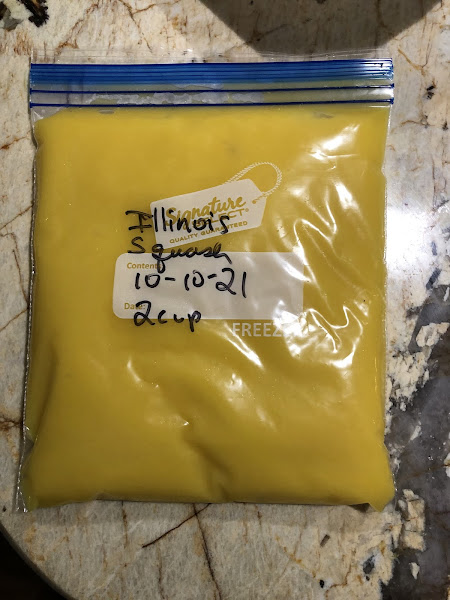
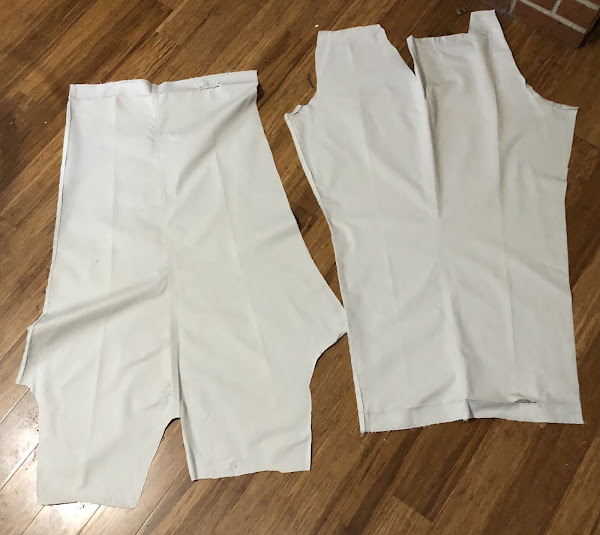




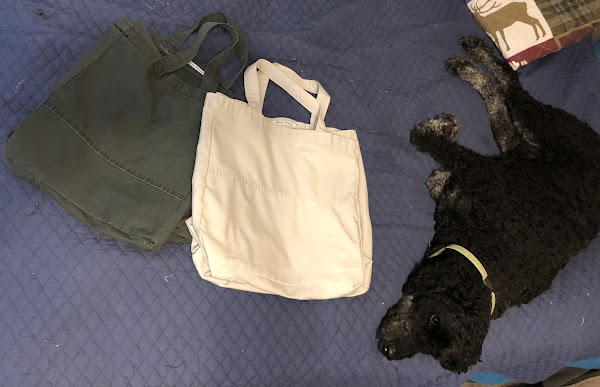







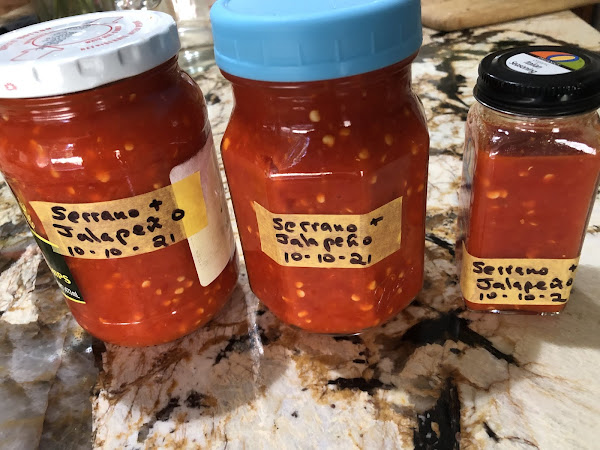

 t
t